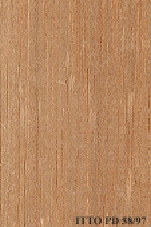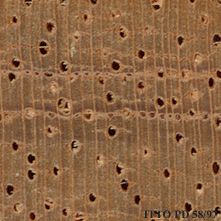
QUARUBA (Vochysia lanceolata)
Trade Name
Quaruba
Scientific Name
Vochysia lanceolata Stafleu
Family
VOCHYSIACEAE
Common Names
Chimbulla (Ecuador); Bellamaria (Ecuador); Cambara (Bolivia); Dormilón (Colombia); Gomo (Colombia); Soroga (Colombia); Goma amarilla (Peru); Quillo (Peru); Saladillo (Venezuela); Iteballi (Guyana); Kwari (Surinam); Wiswiskwari (Surinam); Watrakwari (Surinam); Wanakwari (Surinam); Dima vermelha (Brazil); Quaruba branca (Brazil); Yemeri; Quaruba (Brazil); Guaruba (Brazil); Quillosisa (Peru); Plumero (Bolivia); Salado (Colombia)
Description Of The Tree
Botanical Description
The trees are reported to reach heights of 33 m, with trunk diameters ranging from 60 to 90 cm. The boles are straight and slightly conical, 15 m long or more.
Natural Habitat
Vochysia lanceolata thrives especially in deep soils in the humid subtropical forests.
Natural Distribution
This species occurs in Brazil, Colombia, Venezuela, Peru and Bolivia.
Wood Identification
Anatomic Description Of Wood
Wood diffuse porous. Vessels solitary and in short radial multiples. Tangential diameter of vessel lumina 200 micras or more (large). Vessels per mm2 less than 6 (rare). Simple perforation plates. Vessel-ray pits similar to intervessel pits in size and shape. I Axial parenchyma apparent with the naked eye. Axial parenchyma aliform. Axial parenchyma confluent. 3 to 4 cells per parenchyma strand. 4 to 10 rays per mm (medium). Rays of two distinct sizes. Larger rays more than 4 seriate. Heterogeneous rays and/or multiseriate heterogeneous rays. Occasionally oil and/or mucilage cells associated with the axial and/or ray parenchyma (idioblasts). Body ray Fibers with simple to minutely bordered pits.
-
 Wood Macro Photo Tangential Plane
Wood Macro Photo Tangential Plane
-
 Wood Micro Photo Of Transversal Section
Wood Micro Photo Of Transversal Section
Availability
Cites Status
Unrestricted
General Wood Description
Odor
Odor and taste are indistinct.
Color
The sapwood is yellowish, the heartwood gradually changes into light reddish yellow.
COLOR INDEX (1=Black, 7=Light yellow,white)
5
Grain
The grain is usually straight or interlocked.
Texture
The wood is typically medium in texture.
Luster
The wood surface is described as moderate in luster.
Natural Durability
This species is considered as non durable to moderately durable.
Natural durability index (1= Very high durability, 7=Vey low durability)
6
Resistance To Impregnation
Absorption of oil based preservatives is rated as negligible, but good absorption of CCA salts was reported.
Wood Physical Properties
Basic Density or Specific Gravity (O.D. weight/vol. green) (g/cm³)
0.45
Air-dry Density (Weight and volume at 12%MC) (g/cm³)
0.49
Total shrinkage Tangential (Saturated to 0%MC) (%)
6.0
Total shrinkage Radial (Saturated to 0%MC) (%)
3.6
Recommended Dry Kiln Schedule
UK-A; US-T2-D4
Dimensional stability ratio (Total Tangential Shrinkage %/Total Radial Shrinkage %)
1.7
Wood Chemical Properties
Wood Mechanical Properties
Compression parallel to fiber 12%MC (kgf/cm²)
415
Workability
Sawing
Sawmilling of this species is reportedly easy.
Machining
Machining operations are rather easy.
Planing
Planing is reported to be easy.
Turning
30
Boring
It is easy to bore.
Finishing
Wood of this species is easy to finish.
Response To Hand Tools
The wood responds well to hand tools.
Substitute Species
This species is suggested as a possible substitute of Spanish Cedar (Cedrela spp.) because of its appearance.
REFERENCED USES
End Uses Summary
HOUSING GENERAL, beams, joists, boards, fittings, FURNITURE AND CABINETS, PLYWOOD AND VENEER, TURNING, TOOLS, tool handles, PACKING, CONTAINERS, truck bodies, truck flooring, OTHER AND MUSICAL INSTRUMENTS, shingle
General Housing
- 10 - Silica in Timbers
Beams
- 11 - Prospect: The wood database
Joists
- 12 - Tropical timbers of the world. Part I-Tropical American Species
Boards
- 13 - Dry kiln schedules for commercial woods. Temperate and tropical. Section III. Latin American (Mexico, Central, and South America) Woods–Conventional Temperatures
Fittings
- 19 - Silica in Timbers
Furniture Cabinets
- 21 - Tropical timbers of the world. Part III-Southeast Asian and Oceanian Species.
Panels, Veneers
- 25 - Directory of Timber Trade Malaysia
Turning
- 30 - Embassy of Honduras in Japan
Tools
- 42 - Utilización Industrial de Nuevas Especies Forestales en el Perú.
Tool Handles
- 43 - Maderas de Bolivia (Características y Usos de 55 Maderas Tropicales)
Packing
- 45 - Recopilación y Análisis de Estudios Tecnológicos de Maderas Peruanas
Truck Body
- 53 - Timbers of the New World
Truck Flooring
- 54 - Bulletin of the Government Forest Experiment Station N.157: Identification of Tropical Woods
Shingles
- 77 - Amazonian Timbers, Characteristics and Utilization Volume I; Tapajós National Forest
Please Provide Information To View Producer Information